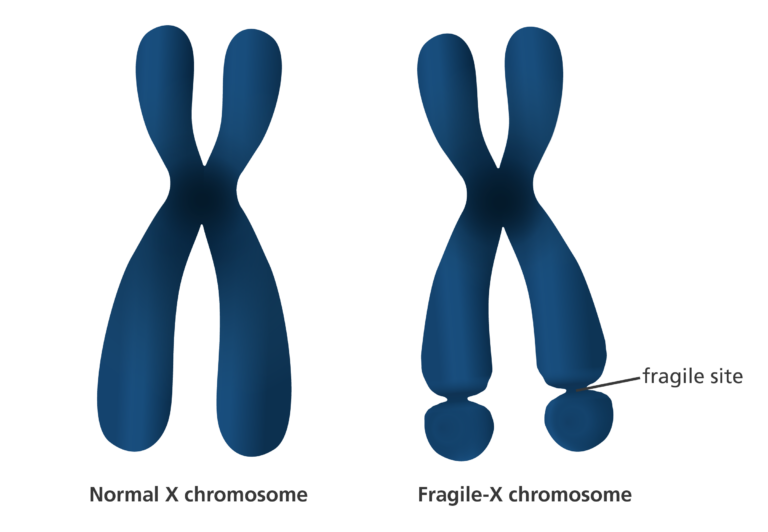What is Fragile-X syndrome?
Image credit: Science Photo Library

Fragile X is an inherited condition that may cause mild or moderate degrees of learning or intellectual difficulties.
- Fragile-X is a common inherited genetic condition that causes intellectual disabilities and learning difficulties.
- It’s called ‘fragile X’ because a mutation creates the microscopic appearance of a gap on the X chromosome.
- Fragile-X is the leading known cause of inherited intellectual disability. It’s also the leading known genetic cause of autism.
What is Fragile-X syndrome?
- Fragile-X syndrome is caused by an insertion mutation in the FMR1 gene, which is found on the X chromosome.
- Typically, this gene contains a stretch of DNA in which a three-base sequence (CGG) is repeated up to about 30 times in a row.
- In people with Fragile-X syndrome this three-base sequence of DNA is repeated over 200 times, known as a ‘trinucleotide repeat expansion’.
- This repetition of bases creates the microscopic appearance of a gap on the long arm of the X chromosome (see illustration below) – hence the name ‘fragile’-X syndrome.

What is the biology of Fragile-X syndrome?
- The FMR1 gene is responsible for providing instructions for making Fragile X Messenger Ribonucleoprotein 1 (FMR1).
- The FMR1 protein plays an important role during brain development, including the development of synapses – the specialised connections between our nerve cells that relay nerve impulses.
- The Fragile-X mutation results in an FMR1 gene that is switched off, which means that the FMR1 protein is no longer produced. This interferes with the way neurons develop.

What are the symptoms of Fragile-X syndrome?
- People with Fragile-X syndrome experience varied symptoms, ranging from mild learning difficulties to severe intellectual disability and communication difficulties.
- Fragile-X syndrome is the leading known genetic cause of autism – up to 6% of children with autism diagnosed with Fragile-X syndrome. Around a third of children with Fragile-X syndrome have autism.
- Around 80% of children with fragile-X syndrome are also diagnosed with attention deficit disorder (ADD) or attention deficit hyperactivity disorder (ADHD).
- People with XY chromosomes only have one X chromosome and will be more affected by the fragile-X mutation and experience more severe symptoms.
- People with XX chromosomes where only one X chromosome is affected are called ‘heterozygous’ for the condition and might experience mild to moderate symptoms. That’s because a mutated FMR1 gene can be compensated for by a non-mutated one.
Symptoms in children who are ‘homozygous’ for fragile-X syndrome (usually with XY chromosomes)
- These people will likely experience developmental delay, meaning they reach developmental milestones, such as sitting and talking, later than children without the condition.
- They are likely to show moderate to severe intellectual disabilities, combined with behavioural problems such as hyperactivity and autism.
- They might also have physical signs of the condition that become more pronounced as they get older. For example, flat feet and extra flexible finger joints.
Symptoms in children who are ‘heterozygous’ for fragile-X syndrome (usually with XX chromosomes)
- These children will likely have mild behavioural problems – but only about 50% will experience intellectual disabilities.
How is Fragile-X syndrome diagnosed?
- Testing for Fragile-X syndrome is recommended if:
- one or more of the disease symptoms are evident in a child
- the biological mother is known to carry a mutation in the FMR1 gene. This can be a ‘pre-mutation’ (with 55 to 200 repeats of the CGG triple) or a ‘full’ mutation (with 200+ repeats).
- if there is a history of unexplained intellectual disabilities in the family.
- Genetic testing looks directly at the FMR1 gene in cells obtained from a blood sample. The number of repeated CGG triplets is counted within the FMR1 gene to identify if there are more than 200 repeats.
- Prenatal diagnosis testing is also possible to determine whether the baby has inherited the mutated gene.
How are people with Fragile-X syndrome supported?
- People with Fragile-X syndrome are usually supported by a multidisciplinary team.
- For example, some children might benefit from specialist education, including occupational and speech therapy. This can also provide great support in managing some of the behaviours associated with ADD or ADHD.
- Some people might take different treatments to help prevent seizures.